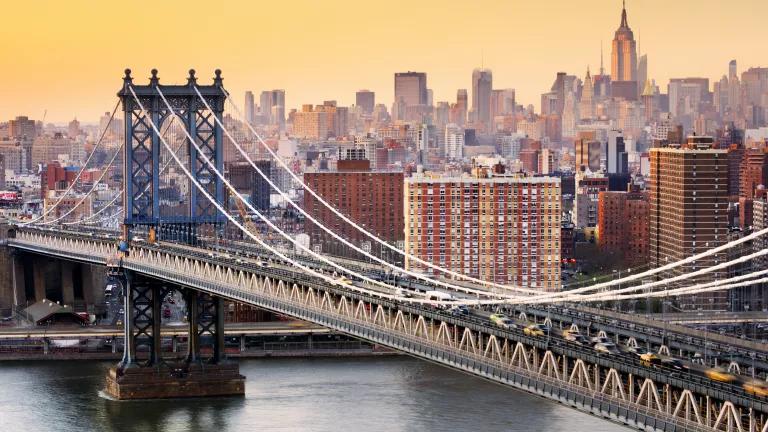Fracking Victory, Ivory Ban, and More Solar Energy: A Year of Environmental Success in New York State
Last year ended with an environmental bang when Governor Andrew Cuomo, in a bold and courageous move that exceeded the wildest expectations of many, banned fracking in New York State. Guided by the growing body of sound science highlighting the health impacts of fracking,and driven by the many grassroots voices demanding that New York not blindly accept fracking within its borders, the Governor capped the year with a powerful statement.
And it's a good thing he did. In the past, the Republic Senate majority (re-elected in November 2014) has not been supportive of an extended moratorium on fracking--aside from the 2009 vote, which passed both houses--and it is likely that the majority would've again deflected or openly opposed the moratorium.
The electoral arc that swept across America in the midterm elections late last year struck New York in roughly the same fashion as the rest of the country. As elsewhere, turnout in New York was stunningly low--compare the 3.6 million or so votes in '14 with the seven million in the pumped up Presidential year of 2012, or even the 5.3 million Pataki-McCall yawner in '02. While Republicans show up in these off years, young voters apparently don't. Add Obama fatigue and the dreaded sixth-year curse--two years into the second term when votes are sick and tired of the same old--and we have the recipe for the Republican rout.
In the New York State Senate races, many of which looked competitive last spring, the Republicans comfortably preserved all three of their open seats, and for good measure, knocked off three incumbent Democrats. One of those defeated incumbents had been elected in the high-water Obama re-election year 2012 by 18 votes, but lost this year by over 10,000.
The pendulum seems to be swinging faster and faster in our over-caffeinated, multi-tasking modern era. In an anomaly, Assembly Democrats actually picked seats in a tidal turnout year for Republicans. But then the Assembly Democrats have a long history of well-funded campaigns with an emphasis on fielding grueling door-to-door operations in tight races -- maybe an old-school model worth investigating for next cycle's House and State Senate campaigns.
Dean Skelos, the Republican majority leader in the Senate, has a clean majority with 32 elected Republicans and at least one, maybe two Democrats who caucus (and vote) with the Republican conference.
So what does this all mean for the environment?
While this Republican majority has similarly not been supportive of initiatives favoring the expansion of solar and wind facilities, it has shown substantial support for a variety of other environment and energy measures. For example, in recent legislative sessions they supported open space protections, ocean conservation measures, recycling programs, funding for energy efficiency programs, broad coastal protections, and, last year, with the superb leadership of Senator Andrew Lanza (Staten Island) and the Long Island Senate delegation, passage of a hard-fought ban on the sale of illegal ivory.
As always, much of the success or failure of environmental efforts has to do with the ability to build as broad a coalition of institutional supporters as possible, most importantly from beyond the environmental ranks.
New York Governor Andrew Cuomo won reelection 54-41 over Rob Astorino, a Republican candidate often at odds and far to the right of his own Party's leadership on environmental issues. Pundits have largely denigrated Andrew Cuomo's victory since it wasn't a blowout of the proportions witnessed in the Pataki era, or even his father's. (Sadly, former New York Governor Mario Cuomo, who founded the Environmental Protection Fund and shut down the Shoreham Nuclear Power Plant during his tenure as governor, passed away on January 1st,-only hours after his son took the oath of office for a second term)
But that misses the point. Last I looked, it takes 51 percent to win an election and besides, it was a tough year for any Democrat to blow anybody out -- though 13 points is pretty convincing.
In his first term, Governor Cuomo was supportive of renewable energy, especially solar. His NY-Sun Initiative, which NRDC strongly supported over the past three years, is a national model. Cuomo's Department of Environmental Conservation led the fight in support of the ivory ban last session and has been important in passing legislation to combat invasive species and coastal erosion, all of which NRDC and other environmental groups supported. These have been substantial achievements for the administration and the environmental community. But we still need to expand in all these areas -- wind facilities, ocean protection, and clean water programs in particular.
Much of Cuomo's legacy is now of course inextricably tied to his courageous action on the issue of fracking. He took seriously the public polls that strongly supported a continued moratorium and paid heed to the unequivocal science on fracking that has found a grave set of health risks associated with the practice. In this new year, hopefully other governors across the nation will begin to follow suit.



